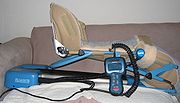
Continuous passive motion
Encyclopedia

Range of motion
Range of motion , is the distance that a movable object may normally travel while properly attached to another object. It is also called range of travel, particularly when talking about mechanical devices and in mechanical engineering fields...
, the exact range is dependent upon the joint, but in most cases the range of motion is increased over time.
CPM is used following various types of reconstructive joint surgery such as knee replacement
Knee replacement
Knee replacement, or knee arthroplasty, is a surgical procedure to replace the weight-bearing surfaces of the knee joint to relieve the pain and disability of osteoarthritis. It may be performed for other knee diseases such as rheumatoid arthritis and psoriatic arthritis...
and ACL reconstruction. Its mechanisms of action for aiding joint recovery are dependent upon what surgery is performed. One mechanism is the movement of synovial fluid
Synovial fluid
Synovial fluid is a viscous, non-Newtonian fluid found in the cavities of synovial joints. With its yolk-like consistency , the principal role of synovial fluid is to reduce friction between the articular cartilage of synovial joints during movement.-Overview:The inner membrane of synovial joints...
to allow for better diffusion of nutrients into damaged cartilage
Cartilage
Cartilage is a flexible connective tissue found in many areas in the bodies of humans and other animals, including the joints between bones, the rib cage, the ear, the nose, the elbow, the knee, the ankle, the bronchial tubes and the intervertebral discs...
(which would be unimportant in the event of joint replacement), and diffusion
Diffusion
Molecular diffusion, often called simply diffusion, is the thermal motion of all particles at temperatures above absolute zero. The rate of this movement is a function of temperature, viscosity of the fluid and the size of the particles...
of other materials out; such as blood and metabolic waste products. Another mechanism is the prevention of fibrous scar
Scar
Scars are areas of fibrous tissue that replace normal skin after injury. A scar results from the biological process of wound repair in the skin and other tissues of the body. Thus, scarring is a natural part of the healing process. With the exception of very minor lesions, every wound results in...
tissue formation in the joint, which tends to decrease the range of motion for a joint. The concept was created by Robert B. Salter
Robert B. Salter
Robert Bruce Salter, , was a Canadian surgeon and a pioneer in the field of pediatric orthopaedic surgery....
M.D in 1970 and, along with help from engineer John Saringer
John Saringer
John H. Saringer is a professional engineer who graduated from the University of Toronto in 1977 and specializes in biomechanics and the development of products to accelerate healing and mitigate the effects of immobility.-Career:...
, a device was created in 1978.
CPM Following Knee Arthroplasty
There is controversy concerning the effectiveness of CPM following Knee ArthroplastyArthroplasty
Arthroplasty is an operative procedure of orthopedic surgery performed, in which the arthritic or dysfunctional joint surface is replaced with something better or by remodeling or realigning the joint by osteotomy or some other procedure.-Background:Previously, a popular form of arthroplasty was...
. Some studies support knee arthroplasty, while others show little or no effect when compared with placebo
Placebo
A placebo is a simulated or otherwise medically ineffectual treatment for a disease or other medical condition intended to deceive the recipient...
. One assessment of multiple studies indicates that CPM following knee arthroplasty gives a total benefit of 0.69 days less in the hospital and 4 more degrees of motion (only at 2 weeks of follow-up) than physical therapy
Physical therapy
Physical therapy , often abbreviated PT, is a health care profession. Physical therapy is concerned with identifying and maximizing quality of life and movement potential within the spheres of promotion, prevention, diagnosis, treatment/intervention,and rehabilitation...
alone. This assessment further suggested that consideration must also be given to patient convenience and CPM cost.

